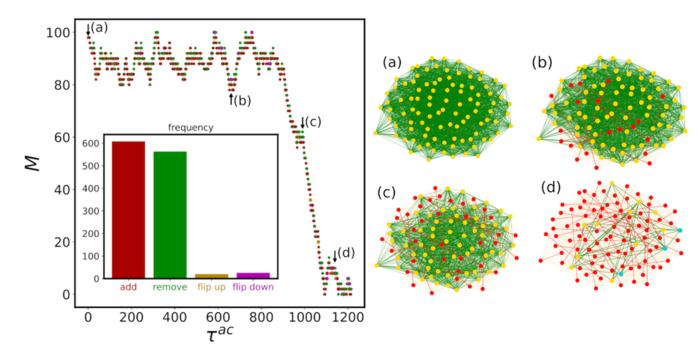Unveiling the Hidden Mechanisms of Abrupt Phase Transitions: A Study in Complexity
Recently, research published in Nature Communications has shed new light on a category of phase transitions previously underestimated in their complexity and unpredictability. These transitions, termed mixed-order transitions, occur when a system experiences a dramatic shift due to a series of minuscule, imperceptible changes at the microscopic level. This intricate dance of particles presents a fascinating challenge, as it contradicts our intuitive understanding of abrupt changes in both nature and social systems.
Typically, we can forecast certain transition points with relative ease. We know, for instance, that water freezes at 0°C under standard atmospheric pressure, and yet many transitions are shrouded in uncertainty. As Jan Korbel, a researcher associated with the Complexity Science Hub (CSH), pointed out, the unpredictable nature of mixed-order transitions can make it nearly impossible to discern how they unfold or when they might transpire. This research signifies a leap in understanding not merely the transitions themselves but the underlying mechanisms that propagate these remarkable changes.
In examining mixed-order transitions, Korbel and his colleagues emphasize the subtlety of what may appear as inconsequential shifts within a system. These transitions manifest through a cascade of minute fluctuations that, when accumulated over time, culminate in a significant change—often leading to unexpected and abrupt transformations. In their study, the researchers pinpointed how these transitory states are interconnected through an intricate interaction network. This revelation connects much of the unpredictability associated with phase transitions to the underlying structures governing particle interactions.
This cascading mechanism is particularly captivating because it uncovers the chaotic relationship between seemingly trivial events and substantial outcomes. For instance, while observing the interaction network within a solid, if one small change occurs—such as the alteration of a single particle’s state—it sets off a chain reaction that can cascade through the network. Korbel emphasized that this process was previously unrecognized, despite phase transitions being conceptualized over a century ago. The focus on mixed-order transitions unveils a critical gap in our comprehension of these complex phenomena.
The implications extend beyond physics; they reverberate through various natural and societal systems. The researchers draw parallels between physical systems, like freezing lakes, and complex social phenomena, such as the outbreak of conflict. Social dynamics often mirror the principle of mixed-order transitions, where the onset of a significant event—such as a war—can seem abrupt and perhaps shocking. In reality, however, underlying tensions and gradual shifts have been accumulating, poised for ignition by a single stir—a seemingly minor political development or economic crisis triggering widespread chaos.
Though their study employs theoretical models rooted in simulations, notably spin models, it emphasizes the necessity of understanding these transitions on both macroscopic and microscopic levels. The researchers replicated the behavior of systems exhibiting mixed-order transitions, where spins of magnetic moments switch between two states. Observing the spin dynamics within these models allowed for an exploration of how energy fluctuations contribute to transition points.
When energy levels shift, it becomes essential for the system to find an appropriate equilibrium. The researchers noted that as systems neared their respective tipping points, the time required for transitioning into a new phase expanded considerably. This analogy can be likened to a rubber band stretched to its capacity—initially, it may withstand strain without visible consequence, but shortly before its rupture, fluctuations intensify, leading to unpredictable breaking points.
Mixed-order transitions introduce a new dimension to our understanding of phase shifts. The research underscores that even when system behaviors appear homogeneous at the macroscopic level, minute and complex interactions dictate how transitions perform across varying conditions, highlighting the role of microscopic mechanics in determining outcomes. Through this lens, Korbel and his fellow researchers reveal how broader realizations about transitional states can enrich our grasp of abrupt changes across disciplines—be it in nature, economics, or societal structures.
What’s particularly striking about this research is its focus on intersections where behavioral science meets physics—the notion that patterns of changing social dynamics might be traced parallel to physical transformations in nature. As the researchers noted, the investigation of mixed-order transitions could lead to potentially groundbreaking developments, offering promising opportunities for understanding predictions relating to societal or environmental shifts and crises.
Ultimately, this research is not just about theoretical advance but about seeking actionable insights that can inform strategies for addressing pressing global issues. As this field expands, incorporating real-world empirical data could pave the way for future chapters of inquiry.
To comprehend how these mixed-order transitions occur in various contexts, ongoing research is essential. The findings programmatically illustrate how our understanding of phase transitions continues to evolve, pushing against the limits of what we thought we knew about abrupt change mechanisms. Up next for the research team is the ambition to utilize Monte Carlo simulations in conjunction with actual real-world data—an endeavor that, if successful, could significantly augment the understanding of both physical and social systems.
Subject of Research: Understanding mixed-order phase transitions through microscopic mechanisms
Article Title: Microscopic origin of abrupt mixed-order phase transitions
News Publication Date: 24-Mar-2025
Web References: Complexity Science Hub, Nature Communications
References: doi: 10.1038/s41467-025-57007-1
Image Credits: Complexity Science Hub
Keywords: Phase transitions, Mixed-order transitions, Complex systems, Unpredictability, Cascading changes, Social dynamics, Spin models, Microscopic mechanisms, Theoretical simulations.




